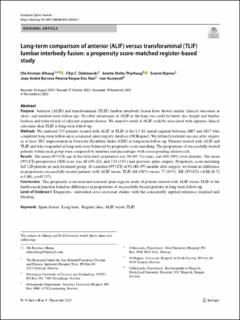| dc.contributor.author | Alhaug, Ole Kristian | |
| dc.contributor.author | Dolatowski, Filip Celestyn | |
| dc.contributor.author | Thyrhaug, Anette Moltu | |
| dc.contributor.author | Mjønes, Sverre Markussen | |
| dc.contributor.author | Roque Dos Reis, Joao André Barroso Pereira | |
| dc.contributor.author | Austevoll, Ivar Magne | |
| dc.date.accessioned | 2024-02-08T14:32:38Z | |
| dc.date.available | 2024-02-08T14:32:38Z | |
| dc.date.created | 2023-12-18T10:25:50Z | |
| dc.date.issued | 2023 | |
| dc.identifier.issn | 0940-6719 | |
| dc.identifier.uri | https://hdl.handle.net/11250/3116437 | |
| dc.description.abstract | Purpose Anterior (ALIF) and transforaminal (TLIF) lumbar interbody fusion have shown similar clinical outcomes at short- and medium-term follow-ups. Possible advantages of ALIF in the long run could be better disc height and lumbar lordosis and reduced risk of adjacent segment disease. We aimed to study if ALIF could be associated with superior clinical outcomes than TLIF at long-term follow-up. Methods We analysed 535 patients treated with ALIF or TLIF of the L5-S1 spinal segment between 2007 and 2017 who completed long-term follow-up in a national spine registry database (NORspine). We defined treatment success after surgery as at least 30% improvement in Oswestry Disability Index (ODI) at long-term follow-up. Patients treated with ALIF and TLIF and who responded at long term were balanced by propensity score matching. The proportions of successfully treated patients within each group were compared by numbers and percentages with corresponding relative risk. Results The mean (95%CI) age of the total study population was 50 (49–51) years, and 264 (49%) were females. The mean (95%CI) preoperative ODI score was 40 (39–42), and 174 (33%) had previous spine surgery. Propensity score matching left 120 patients in each treatment group. At a median (95%CI) of 92 (88–97) months after surgery, we found no difference in proportions successfully treated patients with ALIF versus TLIF (68 (58%) versus 77 (65%), RR (95%CI) = 0.88 (0.72 to1.08); p = 0.237). Conclusions This propensity score-matched national spine register study of patients treated with ALIF versus TLIF of the lumbosacral junction found no differences in proportions of successfully treated patients at long-term follow-up. | |
| dc.description.abstract | Long-term comparison of anterior (ALIF) versus transforaminal (TLIF) lumbar interbody fusion: a propensity score-matched register-based study | |
| dc.language.iso | eng | |
| dc.publisher | Springer | |
| dc.rights.uri | http://creativecommons.org/licenses/by/4.0/deed.no | |
| dc.subject | Ryggkirurgi | |
| dc.subject | Spinal surgery | |
| dc.title | Long-term comparison of anterior (ALIF) versus transforaminal (TLIF) lumbar interbody fusion: a propensity score-matched register-based study | |
| dc.title.alternative | Long-term comparison of anterior (ALIF) versus transforaminal (TLIF) lumbar interbody fusion: a propensity score-matched register-based study | |
| dc.type | Peer reviewed | |
| dc.type | Journal article | |
| dc.description.version | publishedVersion | |
| dc.subject.nsi | VDP::Ortopedisk kirurgi: 784 | |
| dc.subject.nsi | VDP::Orthopaedic surgery: 784 | |
| dc.source.journal | European spine journal | |
| dc.identifier.doi | 10.1007/s00586-023-08060-1 | |
| dc.identifier.cristin | 2214703 | |
| cristin.ispublished | true | |
| cristin.fulltext | original | |
| cristin.fulltext | | |
| cristin.qualitycode | 1 | |

